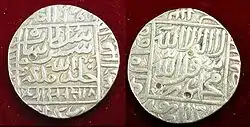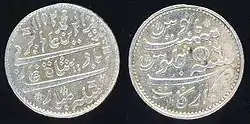Indian 1-rupee coin
The Indian 1-rupee coin (₹1) is an Indian coin worth one Indian rupee and is made up of a hundred paisas. Currently, one rupee coin is the smallest Indian coin in circulation. Since 1992, one Indian rupee coins are minted from stainless steel. Round in shape, the one rupee coins weighs 3.76 grams (58.0 grains), has a diameter of 21.93-millimetre (0.863 in) and thickness of 1.45-millimetre (0.057 in). In independent India, one rupee coins was first minted in 1950 and is currently in circulation.
India | |
| Value | ₹1 |
|---|---|
| Mass | 3.09 g |
| Diameter | 20 mm (0.79 in) |
| Composition | Stainless steel |
| Years of minting | 1950–present |
| Mint marks | ♦ = Mumbai B = Mumbai Proof issue * = Hyderabad ° = Noida No mint-mark = Kolkata |
| Obverse | |
 | |
| Reverse | |
History
Sur Empire
Sher Shah Suri, the founder of the Sur Empire ruled North India from 1540 to 1545 AD. [1] During his reign, Suri issued pure silver coins in 1542 and named it Rupiya (from Sanskrit रौप्य, raupya, meaning silver). The denomination remained in usage through the Mughal, Maratha, East India company and British rules.[2][3] The rupiya was retained by the East India company till 1835 and formed the basis of the British Raj currency till 1947.[4] Each rupiya coin weighed 178 grains (11.5 grams). The sub-unit of rupyia were copper pieces and 40 copper pieces constituted as one rupiya. Sher Shah Suri named the copper pieces as Paisa.[2][4][5]
| 1 Rupiya coin (Sher Shah Suri) | |
|---|---|
 | |
| Obverse: Trace of Kalima, name of four Khalifas, Sher Shah Suri's name and pious wish "Khald Allah mulk". | Reverse: Name of mint (some coins bore word "Jahapanah" instead of mint name) and date. |
| Coins were minted in different mints like Ujjain, Agra, Punduah, Chunar, Satgaon etc. | |
Madras Presidency
The Madras Presidency issued one rupee coins until 1815 AD. One rupee was equal to twelve fanams.[5]
| 1 Rupee coin (Madras Presidency) | |
|---|---|
 | |
| Obverse: | Reverse: |
East India company
In the 17th century AD, the East India Company wanted to introduce the Pound sterling in India. Due to the popularity of the Rupiya, the Pound sterling could not be introduced in India. It was only in 1717 AD that the English obtained permission from the Mughal emperor Farrukhsiyar to coin Mughal money. In 1835 AD, the Coinage Act of 1835 for uniform coinage came into force.[2][6] Composed of 0.917 silver, the new one rupee coins weighed 11.66 grams (179.9 grains) and had a diameter of 30.55 millimetres (1.203 in). The reverse of all one rupee coins minted after 1835 and before 1862 AD bore "East India Company" instead of the country's name.[7] The one rupee coins had bust of King William IIII (IV minted as IIII) and were first minted in 1835 AD.[8] Rupee coins issued after 1840 bore the busts of Queen Victoria (1840 to 1901 AD), Edward VII (1903 to 1910 AD), George V (1911 to 1936 AD) and George VI (1938 to 1947 AD).[2][9]
British Raj
The British Raj started in India in 1858 AD after a century of control by the East India Company. The British Raj lasted until Indian independence in 1947.[10] From 1835 to 1858, uniform rupee coins were being issued in accordance to the Coinage Act of 1835.[2][6] In 1862, new one rupee coins were issued, were known as the Regal issue, bore the bust of Queen Victoria on the obverse and the country name "India" minted on the reverse side. One rupee coins issued after 1835 but before 1862 AD had "East India Company" on reverse instead of country name.[7] From 1862 to 1939 AD, one rupee coins were minted from 0.917 silver, weighed 11.66 grams (179.9 grains), had a diameter of 30.78 millimetres (1.212 in) and thickness of 1.9 millimetres (0.075 in). The obverse side of the coins featured the busts of Queen Victoria (1862 to 1901 AD), Edward VII (1903 to 1910 AD), George V (1911 to 1936 AD) and George VI (1938 to 1947 AD). Edward VIII was never featured on any one rupee coin since his reign (Jan-Dec 1936 AD) was short.[2][9]
Due to World War I and II, there was a shortage of silver. As a result of the shortage, 0.917 silver one rupee coins were replaced by Quaternary silver alloy (0.500) in 1940. In 1947, the silver one rupee coin was replaced by nickel coins.[2]
One rupee coinage from 1835 to 1947
| One Rupee coins (1835 to 1947): East India Company and British Raj | ||||||||||||
|---|---|---|---|---|---|---|---|---|---|---|---|---|
| Image | Technical parameters | Description | Year of minting | Known mintage | Comments | |||||||
| Obverse | Reverse | Weight | Diameter | Thickness | Metal | Edge | Obverse | Reverse | First | Last | ||
_-_Obverse_01.jpg.webp) | _-_Reverse.jpg.webp) | 11.66 g | 30.5 mm | 1.9 mm | Silver (0.917) | Reeded | Bust of King William IIII with his name. | Face value, country and date surrounded by wreath. | 1835 | 1840 | 69,472,000 [11] | |
-4037.jpg.webp) | -4038.jpg.webp) | 11.66 g | 30.78 mm | 1.9 mm | Bust of Queen Victoria surrounded by her name. | Face value, country and date surrounded by wreath. | 1840 | 1901 | 2,454,825,107 [7] | |||
.jpg.webp) | 11.66 g | 30.6 mm | 1.9 mm | Bust of Edward VII surrounded by his name. | Face value, country and date surrounded by wreath. | 1903 | 1910 | 849,622,000 [12] | ||||
.jpg.webp) | 11.66 g | 30.5 mm | 1.9 mm | Bust of George V surrounded by his name. | Face value, country and date surrounded by wreath. | 1911 | 1936 | 1,807,479,000 [13] | Coins minted in 1911 had nick name "pig rupee".[2] | |||
.jpg.webp) | 11.66 g | 30.5 mm | 1.9 mm | Bust of George VI surrounded by his name. | Face value, country and date surrounded by wreath. | 1938 | 1939 | 772,980,000 [14] | ||||
.jpg.webp) | 11.66 g | 30.5 mm | 1.9 mm | Silver (0.500) | Security | 1939 | 1945 | |||||
_-_Obverse.jpg.webp) | _-_Reverse.jpg.webp) | 11.8 g | 28 mm | 2.48 mm | Nickel | 1947 | 1947 | 160,039,000 [15] | Only minted in 1947. | |||
Independent India
On 15 August 1947, India obtained independence and the monetary system and coinage of the British Raj were retained. It was not until 15 August 1950 that India introduced new coins. Introduction of new coins (including one rupee coin) was done in following chronology and reasons;[10][16]
- Motifs and symbol of sovereignty were adapted to represent Indian independence.
- Introduction of metric system and related impact on Indian coinage.
- Changes due to metallic value of coins.
- "Coinisation" of currency notes for cost-benefit.
Subunits
From 1947 to 1957, the Indian rupee was not decimalised and was divided into 16 annas. Each anna was further divided to four Indian pices (from 1835 to 1947, each pice was divided into three Indian pies; till the pie was demonetized in 1947). Table below shows sub-units of one rupee (1835-present).[3]
| Denomination | Sub-unit | Sub-unit | Sub-unit | From | To | Comments |
|---|---|---|---|---|---|---|
| Rupee | Anna (1 Rupee=16 Anna) | Pice (1 Anna = 4 Pice) | Pie (1 Pice = 3 Pie) | 1835 | 1947 | Pie demonetized in 1947. |
| - | 1947 | 1950 | The Frozen Series | |||
| 1950 | 1957 | The Anna Series | ||||
| Paisa (1 Rupee = 100 Paisa) | - | - | 1957 | 1964 | Naya Paisa Series. Anna & Pice demonetized in 1957. | |
| 1964 | Present | Except 50 paisa, all lower coins demonetized. | ||||
| (1835-1947): 1 Indian rupee = 16 anna = 64 pice = 192 pie. (1947-1957): 1 Indian rupee = 16 anna = 64 pice. (1957-1964): 1 Indian rupee = 100 naye paise. (1964-present): 1 Indian rupee = 100 paise.[16] | ||||||
Mintage
Mintage
As of 2020, one rupee coins are minted by the India Government Mints in Mumbai, Kolkata, Hyderabad and in Noida. All coins are circulated only through the Reserve Bank of India.[17]
Mint marks
The following mint marks have been used on one rupee coins since 1947.[18][19][20]
| Mint | Mark | Description | Comments |
|---|---|---|---|
Coins minted in Indian mints | |||
| Hyderabad | ☆ | Five-pointed star | |
| Kolkata | No mint-mark | Since this was the first Indian mint, coins minted in Kolkata don't carry a mark.[18] | |
| Mumbai | ♦ | Diamond | |
| • | Small dot (solid) | ||
| B | Letter B below year | ||
| M | Letter M below year | On coins minted after 1996. | |
| Noida | ° | Small dot (hollow) | |
Coins minted in foreign mints | |||
| Birmingham | H | Letter H below year | One rupee coins (KM# 79.1) in 1985 were also minted in Birmingham mint, United Kingdom.[19] |
| Kremnica | mk | Letters "mk" in circle | One rupee coins (KM# 92.2) from 1998 to 2001 were also minted in the Kremnica mint, Slovakia.[20] |
| Mexico | Mo | °M, letter "M" beneath circle | One rupee coins (KM# 92.2) in 1997 were also minted in the Mexican Mint.[20] |
| Pretoria | M | Letter "M" in oval | One rupee coins (KM# 92.2) from 1998 to 2000 were also minted in the Pretoria mint, South Africa.[20] |
| Royal Mint | • | Small dot | One rupee coins (KM# 79.1) in 1985 were also minted in Royal Mint in Llantrisant, United Kingdom.[19] |
See also
References
- Majumdar, R.C. (ed.) (2007). The Mughul Empire, Bharatiya Vidya Bhavan, ISBN 81-7276-407-1, p.83
- "Facts about Indian coinage". mymoneysage.in. Retrieved 29 August 2017.
- "History of Indian coins". indianumismatics.wordpress.com. Retrieved 29 August 2017.
- "History of Pashtuns". barmazid.com. Retrieved 29 August 2017.
- "Interesting Facts about Rupee and Coins". mapsofindia.com. Retrieved 29 August 2017.
- "British India Coinage". Reserve Bank of India. Retrieved 30 August 2017.
- "Queen Victoria coin variants". Numista. Retrieved 30 August 2017.
- "1835 one rupee". Numista. Retrieved 30 August 2017.
- "British India 1 rupee coins". Numista. Retrieved 30 August 2017.
- "British Raj". BBC. Retrieved 30 August 2017.
- "William IIII coin variants". colnect.com. Retrieved 30 August 2017.
- "Edward VII coin variants". Numista. Retrieved 30 August 2017.
- "George V coin variants". colnect.com. Retrieved 30 August 2017.
- "George VI coin variants". colnect.com. Retrieved 30 August 2017.
- "George VI Nickel coin". Numista. Retrieved 30 August 2017.
- "Republic India Coinage". Reserve Bank of India. Retrieved 28 August 2017.
- "Indian coins". Reserve Bank of India. Retrieved 28 August 2017.
- "Mint marks". indian-coins.com. Retrieved 28 August 2017.
- "Mint marks (abroad 1)". Numista. Retrieved 28 August 2017.
- "Mint marks (abroad 2)". Numista. Retrieved 28 August 2017.